
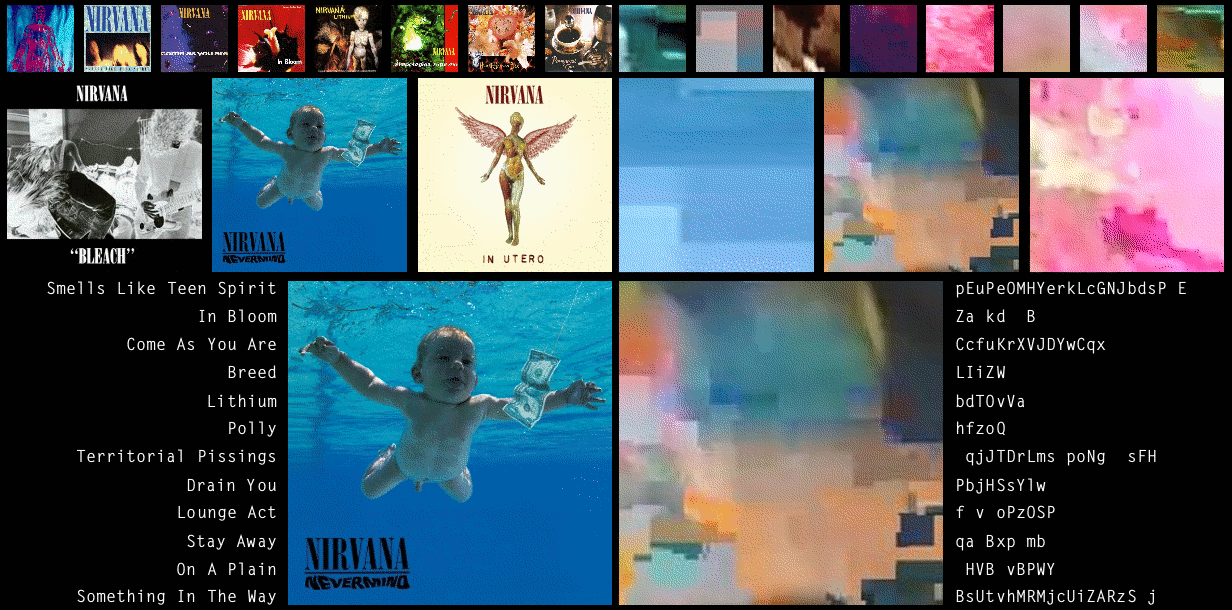
Corpus Companion is a system for creating a complete Companion body of work, based on the parameters of an Original body of work.
The American band Nirvana was active from 1987 until Kurt Cobain’s death in 1994. I will use its body of work as the example for Corpus Companion’s working procedure, as it is well-known, well-documented, and “complete” (ie no additional material will be created).
Nirvana’s Audio / Visual discography includes:
… as well as a large collection of (for lack of a better term) apocryphal material such as demos, home-recorded cassette tapes, and concert bootlegs, some of which have been released in post-1994 albums or leaked online.
Naturally, we will run into some grey areas here; such as 3rd-party artwork which was specifically commissioned by Nirvana for use in official releases. Also in question are materials such as official correspondence (both personal and legal), interviews, and works which were created but remained unused (such as alternate cover photos for Nevermind featuring a female baby).¹
Along with this, a massive amount of promotional material (such as posters, T-shirts, and other merchandise) was — and still is — created in support of the band, by non-members of Nirvana (but inclusive or derivative of their works). There also exists a parallel and ongoing stream of criticism, analysis, and documentation specifically instigated by Nirvana’s work… which I am considering a distinctly separate entity.²
For the sake of expediency, in this example I will be limiting the concept of Nirvana’s “body of work” to the list of A/V materials detailed above.
Once we have limited Nirvana’s body of work in this way, additional questions arise as to the variation in medium and intratextual aspects of a single work. I will use Nevermind as the example here.
The Discogs master page for Nevermind lists 360 separate versions(!) of this album; covering international releases (which sometimes have different record labels or distributors), different formats (such as cassette, CD, vinyl, or digital), promos for radio stations, and even sketchy bootlegs.

This dizzying variety of releases creates variance in the musical and artistic content of the work itself:
Some releases end with Something In The Way, without including the 10-minute silence and “secret song” Endless, Nameless. Digital versions tend to include this song as a discrete track, but without the 10-minute gap. Cassette tape versions include different amounts of silence to even out the length of the sides — and some (presumably) might include the test tones common to cassette manufacture at that time. More recent Deluxe, Super Deluxe, and Anniversary editions include an enormous amount of additional material — sometimes eclipsing the total runtime of the original album. Remastering, format-specific mastering (such as for vinyl), and different digital encoding formats change the character and technical aspects [such as the avg. RMS and frequency content] of the audio.
As for artwork and packaging: some re-releases have completely different artwork from the first pressings. The covers for promo versions are sometimes template-based and text only. Some CD releases had additional longbox packaging. Japanese versions include Obi strips. The color and marbling of the vinyl releases are highly variable, and there are at least three different official picture disc releases. These intratextual differences can be as minute as weather the inner sleeves of otherwise-identical LP releases are 90° or rounded; or even completely identical packages save for a different UPC or catalog number to indicate a repressing.
In order to proceed, we will need to select a canonical version of each work, and limit the scope of which aspects will be considered for replication. At this point, I decided it would be prudent to obtain a copy of Nevermind to use in the following examples.
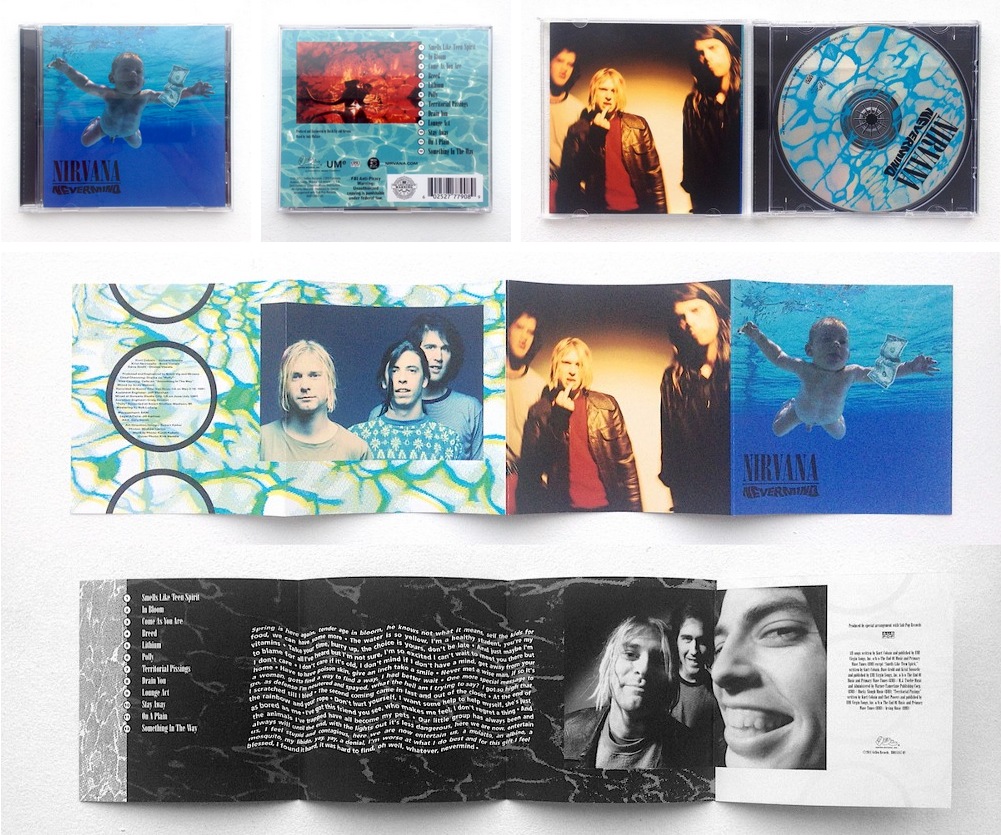
Comparison notes and a personal letter from a friend-of-a-friend.
Excepting studio and manufacture-related items like master tapes and vinyl test pressings, the pre-release promos are the first extant versions of Nevermind. However, many lack the commercial artwork, and they weren’t widely available for purchase. The initial 1991 releases feel most appropriate to use for this, but there is still the question of format.
Vinyl hadn’t yet come back into vogue in 1991, and Nevermind lies right at the cusp of the mass consumer adoption of CDs. Cassette production peaked in ‘88, and ‘91 was the last year Cassettes outsold CDs — although the transition to CD dominance happened slowly through the rest of the decade. I couldn’t find stats on Nevermind’s sales across formats, but it was released in September of ’91, and hit #1 in January of ’92; so presumably either could have been the most-purchased format. [1]
Of these three 1991 configurations, the Cassette’s artwork is the most divergent in regard to layout. The photographs are cropped and quite small (the monkey photo especially). The album cover appears to be designed for a square format, in the cassette it is extended downward with solid blue.
So, this leaves us at a toss-up. Though this is admittedly arbitrary, the first copy of Nevermind I recall seeing was a CD… so that’s what I’m going with.

Echo Bay appears to be the best spot for tracking down original pressings of Nevermind, but I didn’t want to wait for shipping — so I decided to make like ‘91 and go visit a music store. [2]
The Excelsior shopping center is a great spot if you’re looking for musical instruments, sports or camera equipment, and rock ’n’ roll apparel (band tees, studded belts, bandanas, etc). A few record stores are tucked away in this complex, but (sign of the times!) they mostly stock vinyl. Only one of the four record stores which were open had a CD copy of Nevermind: Memphis Music in B1. Rock on Memphis Music!
The version Memphis had in stock was a remastered 20th anniversary edition, but it is clearly aiming at replicating the original CD pressing. In order to make a detailed comparison, I reached out to my friends to see if anyone still had a complete copy of the original ‘91 CD. A quick note about the streaming versions
In 2016, digital versions of Nevermind can be easily streamed or purchased from iTunes, Spotify, or Amazon — but all of these versions omit key aspects of the work. They all include the song Endless, Nameless… but not the gap of silence which precedes it in most CD and cassette versions. None include a “digital booklet”. iTunes includes both the standard and deluxe editions, but does not specify weather the standard version was digitized from the original or 2011 remaster (the previews sounded like the remaster). Spotify’s multiple versions have similar issues.
Side-By-Side ComparisonMy friend Eliot (whom I have never actually met IRL, even though we email all the time and have made some tracks together) put me in touch with his friend Christopher, who was kind enough to take some photos of his 1991 pressing of Nevermind:
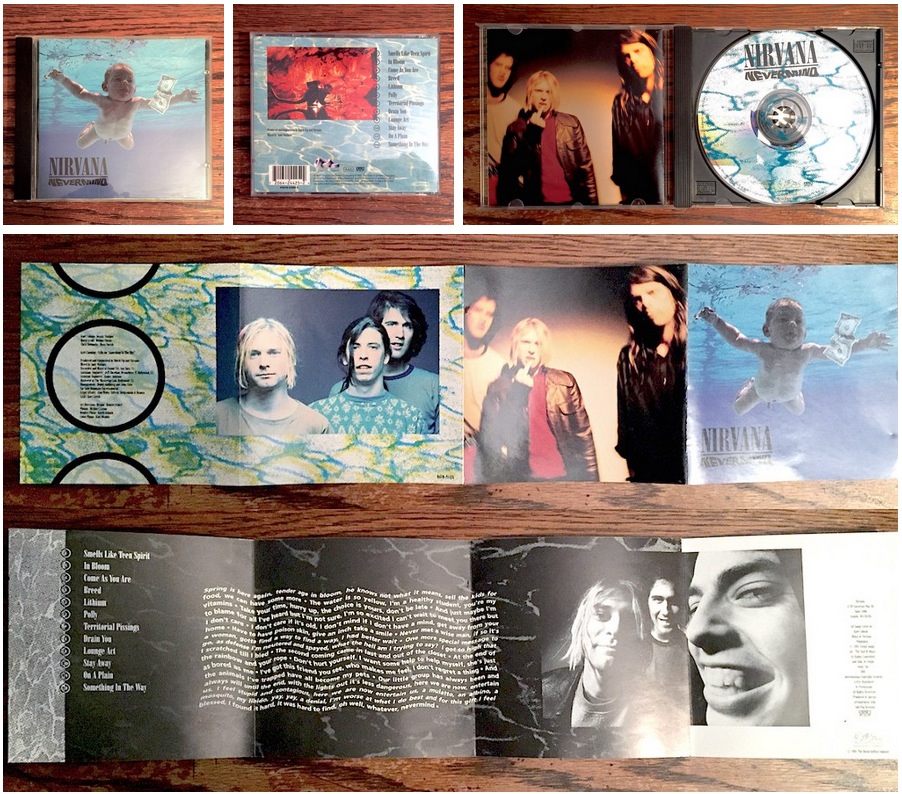
Keen viewers might notice this is the Canadian pressing, as indicated by the “PRICE CODE V” below the UPC and the Ontario mailing address listed for DGC. Compared with my 2011 version, there are a few immediately noticeable differences, such as the logos on the back:
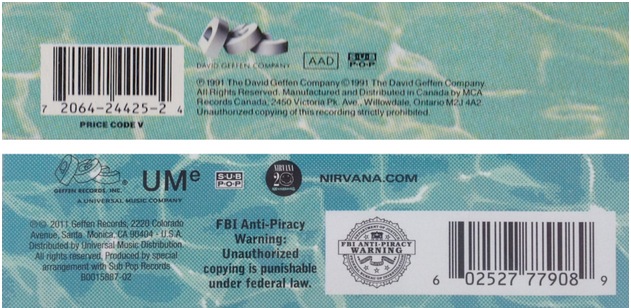
…but upon close inspection, much of the graphic design is quite different. You may have noticed the the underwater graphics above don’t match up. Actually, the underwater graphics on the disc face, the back, and the color portions of the inside have been completely replaced:
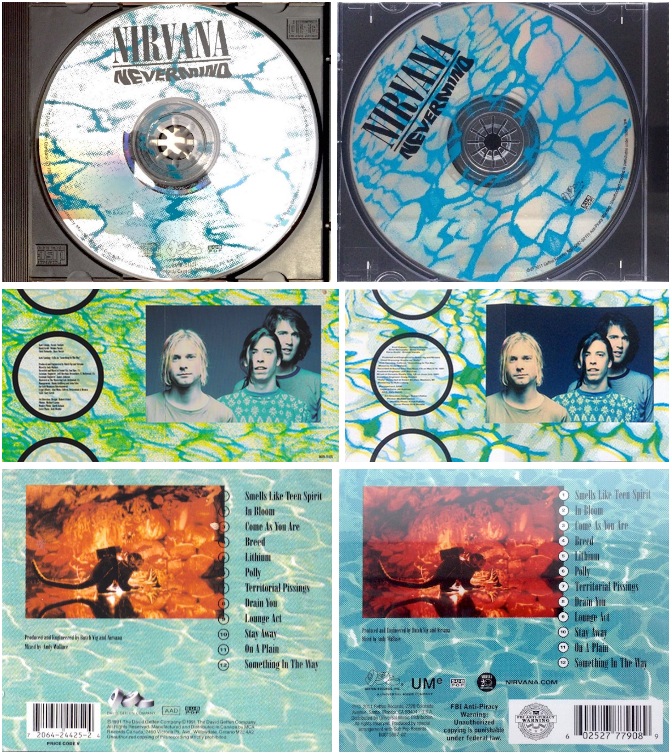
Along with being completely different photos, the 2011 version uses the photo effects in a different way: the inside now includes much more white space than the original, and the back is more heavily posterized, with the newsprint effects using larger “ink dots”.
Differences also exist in the typography, most noticeably the white backgrounds added behind the track numbers (also present on the insert), but these differences extend to the content itself, and justifications and arrangement of the text and logos on the insert.

Ironically, this indicates the graphic designers were already working in a way which parameterized key aspects of the work. Consciously or not, a decision was made that “the artwork of Nevermind” was not “this particular photo of water with these particular effects”, but rather “any photo of water, with a similar set of effects”.
The 2011 pressing’s revisions seem intended to visually clarify; but from a conceptual, or archival / taxonomic standpoint they do the exact opposite. By deciding to replace entire portions of the original work, they have instead contributed to a branching notion of what the work actually is.
The album’s remastering also falls into this category of false-clarification. The 2011 remaster utilizes a style of aggressive multiband compression which reveals many more details [eg. the now-present high end and clearer spatial definition of the “hello / how low” vocals], but also fundamentally changes the character of the audio in such a way that one now needs to specify which version of the album they’ve listened to.
Even after all of the 2011 version’s comparatively subtle changes, there is one aspect of the 1991 pressing which there is no way to replicate in any meaningful way: that is, simply, a quarter-century’s worth of existence.
Like many in my cohort, once in the era of ubiquitous streaming, I decided to divest myself of most of my physical music collection. But in the process of boxing up these items to sell at Dimple Records, I found there were some albums my heart would not allow me to give up. Perhaps you’ve had a similar experience.
Nevermind is not one of these albums for me. As a classic moody teenager, I connected with bands like NIN, Tool, and The Deftones for their technical writing and gloomy, theatrical aesthetics. I didn’t come around to Nirvana until I was in my late 20s, after watching some of their live concert videos.
But for many people my age, Nevermind and In Utero were the albums that laid anchor and remained. The shock of these fierce, inflammatory performances, poetic lyrics, and thundering productions translated something particular — and true — about the experience of youth in the 90s. Cobain’s untimely death and the closing of Nirvana’s body of work encased forever these few years in both the public consciousness and the hearts of those who deeply connected with this material.
I asked Christopher to tell me about his experience with this particular item, which has been with him now for two decades. He replied as follows:
The first time I saw a copy of Nevermind was probably in 1992 (I was twelve). I was visiting my cousin and his older sister had a copy of the cassette tape. I remember being intimidated by the picture of the baby in the water. Although I didn’t understand why, or even have the words to explain it, the subversive cover made me uncomfortable. Although to be fair, my cousin’s two older sisters were terrifying teenagers, so that may have had more to do with it then the naked baby.
I didn’t hear what was on that tape until about a year later when a friend of mine got the cassette tape as part of the Columbia House free tapes in the mail deal. I was a sensitive kid, and although I felt uncomfortable with the violent sounds on the record, that didn’t stop me from falling in love with the songs and the melodies. The upbeat melodic writing wrapped in the angry electric guitars and loud drums was just the right ratio of bitter and sweet. We would sit in his room and listen to his tapes and look at the tape jackets. I always like the picture of the band where they are smiling and Kurt has a bit of pink in his hair. My friend liked the blurry picture where Kurt of flipping off the camera. Those two pictures capture the tension of that record so well. That was also the year I learned to play the guitar, and once I figured out what a power chord was, Smells Like Teen Spirit was the first song I learned.
I didn’t get the CD that I have now until 1995. My parents were pretty conservative, and understandably they didn’t think that Nirvana was very age appropriate for a 13 year old. When I was 15 I started dating a girl who had grown bored of her grunge CDs, and gave me all her Nirvana records. I knew all the music from listening at friends houses (and having a few mix tapes that my parents didn’t know about), but they we’re the first CDs that I really ever owned.
Last year I move into a smaller condo and didn’t have room to keep my entire CD collection. I fought the death of the CD for a long time, but before the move transferred my entire CD collection onto a hard drive. I had to go down into the basement and dig through a couple of boxes to find the Nevermind CD. Looking at the jacket and the pictures reminded me of how much I miss the ritual of handling the CDs and looking at the jackets while listening to the music. I still really like Nevermind. I don’t think the record production has aged as well as some of their other records, but still think the song writing is amazing.
The picture I sent is me with an 18th year old whiskey in one hand, and my 2 week old son in the other. I married the girl that gave me that Nevermind CD. I guess I really like the record and the girl.

I’ve now had my copy of Nevermind sitting on my desk for about a week. It is, perhaps, a compromised, perameterized, ersatz version of the original work — but this is a judgey (and perhaps meaningless) perspective.
I wonder, when pulling this object from a box in the attic in the year 2031, what I will remember about these first few months in Singapore, and what these meandering days will eventually mean to me?
After some consideration, I decided on the initial 1991 US commercial CD pressing as the ideal canonical version. The copy I managed to acquire is a 20th anniversary reissue, but it adheres closely in most respects to the original (see the Side Quest for specifics). From here, we can begin to break down the constituent elements of the work, which I will do starting from the outside and moving inward.
This album is enclosed a clear Jewel Case, and includes a 4-page, 8-pannel [ie: double sided] insert, tray card, and CD with on-disc printing. There are several different options for folding this type of insert, and the printers I checked described this style as a “Rollfold” or “Folder Roll”.
The outside pages of the insert are full-color, and the inside are black and white. Both the inside and outside are glossy. I am not savvy enough to identify the variety of paper and ink used by sight, texture, or smell.
The tray card is full color on the outside, and solid black on the inside. The original ‘91 pressing used an opaque grey plastic tray. The on-disc printing is one color with black text, which extends beyond the “mirror band” into the clear plastic area. The dimensions of these items are industry-standard and easily handled in programmatic contexts.
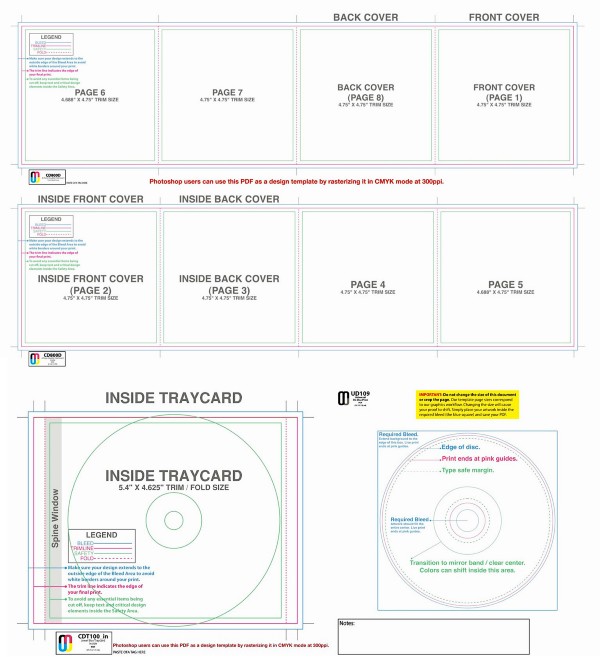
The artwork for this album is a mix of photography, text, logos, and other graphic design elements (such as the black circle enclosing the production credits). These elements are universal to commercial visual art, and (again) are easily handled in programmatic contexts.
The majority of the text is informational. The band’s name, and album title appear 4 times in total. Track numbers and titles are included both on the tray card and insert. The band members and other contributors are listed. The catalog number appears 5 times. The only non-informational text appears on the insert, which is comprised of lyrical excerpts and unused lyrical/poetic fragments.
There are 3 photographs of the band members on the insert. The cover and back photos are figurative (the photo on the back is of an assemblage by Cobain). A graphic design motif of stylized water ripples is used throughout the artwork and printed on the disc.
Compact Disc Digital Audio (colloquially: Red Book) is encoded in 16 bits at a 44.1kHz sampling rate, in 2 discrete channels [ie stereo]. In practice, when pressing a CD, one usually provides the manufacturer with audio files in a more common LPCM format such as WAV or AIFF. However, the CDDA spec includes aspects beyond only audio storage, such as an index of track numbers and start times, and other metadata.³
Nevermind includes almost an hour of audio, divided into 12 tracks. Aside from being available on the disc itself, track timing and title information are accessible through commercial online databases such as Gracenote, or in a less precise way through free sites like Discogs or Wikipedia.
Nevermind’s music is based around a core instrumentation of electric guitar, electric bass, drum kit, and vocals; though additional instrumentation is sometimes used. Guitar and bass are often distorted, and some vocal and guitar performances utilize extended techniques. Recording and production features (overdubs, audio effects, etc.) are present throughout.
Structurally, Nevermind’s songs are written in variations of the verse-chorus form common to contemporaneous American pop music. Most songs are arranged with sparser verses and denser choruses, wherein the guitars are usually doubled and the vocals are often harmonized. Polly and Something in the Way feature acoustic guitar and more relaxed performances.
Every song is in common time, though some include moments of free time. Notably, these songs feature a fair amount of harmonic variety and mode changes; perhaps stemming from being composed primarily on guitar, and being influenced by bands and artists with similar guitar-based writing.
Cobain described Nevermind’s lyric writing process as haphazard, last-minute, and somewhat perfunctory; many of the lines were lifted from his previously-written poems. Owing to this, many of the lyrics are more suggestive or figurative than concrete. Often a song’s sections will be contrasted; where one will use rhyming couplets, and another will be in free verse. Slant or off rhymes are occasionally used. Sometimes a single word or phrase will be repeated several times in succession.
In the body of writing about the music of Nevermind, its aesthetics are likely its most discussed feature. The members of Nirvana considered their music as existing in a continuity stemming from blues in the American South; but saw rock, punk, postpunk, hardcore, and new wave bands as their primary points of extension. In non-sarcastic interviews, they usually referred to themselves as a “rock band.”⁴
Once we’ve identified the scope of a body of work, and the parameters of each constituent work, we can begin the process of creating companion works.
Given the nearly unlimited range of options for this process, I’ve included the following list to organize my thoughts on the feasibility of different approaches. In reality, these options are fluid rather than discrete. This list is ordered from the most feasible to the least feasible.
For a reasonable balance of effort and artistic “effectiveness,” I think something comparable to #3 is the strongest option. I like the idea of Companion Works occupying identical temporal and (theoretically) spatial parameters to the Original. While executing Companion Works, I imagine an artist would naturally respond to the original’s artistic content and parameters in both conscious and subconscious ways.
Programmatic assistance could be used in the collection and collation of data related to an Original Work’s parameters, and stochastic or generative techniques could be used to quickly create large amounts of material falling within selected parameters (which could be presented as-is, or used as a starting point).
The final step of physical medium replication presents by far the most challenges, including elements such as working with manufacturers to ensure matching packaging parameters, as well an increase in budget.
It doesn’t take long to imagine how applying this system to increasingly complex or large bodies of work quickly spirals into the realm of logistical impossibility. Creating corpus companions for (just to name a few) Zhang Yimou, C.Y. Lee, or The Internet Archive — beyond only the most cursory forms — would prove daunting.
Likewise, using a broad notion of a “body of work” (which might include the output of governmental organizations, military generals, the commercial output of entire economies, etc. etc.) quickly introduces ethical concerns well beyond the intended scope and commentary of this project.
In August of 1991, a month before Nirvana would begin the Nevermind sessions in LA, Tim Berners-Lee rekindled his World Wide Web project; posting an explanation of the WWW on the alt.hypertext usegroup, along with a code library designed for the creation of web browsers.⁵
Kurt Cobain committed suicide in April of 1994. Eight months later, Netscape Navigator 1.0 was released to the general public. Nirvana are one of the last musical acts to have significantly altered the dominant trend of popular music before the mass adoption of the Internet in America.
At present, we find ourselves in the golden age of the archive. Our problem is no longer how or where to acquire material… but which material should be traversed, how best to traverse it, and which associated works and historical contexts should be addressed in the traversal.
Such concerns — once relegated only to the foofy realms of academia and criticism — are now relatively commonplace. Will your Twitch audience troll you if you skip the snowboarding minigame at The Gold Saucer during your FFVII playthrough? Should you torrent the FLAC rip of the original pressing, or buy the 180 gram vinyl reissue to get the most authentic listening experience — or reject outright the notion of an authenticity hierarchy? Prior to traversing the filmography of John Waters, should you first read Susan Sontag’s Notes on Camp?
In recent years, the accessibility of entire bodies of work has instigated new projects in unexpected ways. Podcasts such as Denzel Washington Is The Greatest Actor Of All Time Period, Gillmore Guys, and The West Wing Weekly use bodies of work as a starting point rather than the exclusive focus — expertly honing the topical judo required to stay relevant to modern discourse. Bodies of work (particularly closed bodies of work) are easy fodder for internet light reading like listicles, #TBT posts, and comedic writing about an otherwise-beloved artist’s questionable forays into then-current trends.
Soon pop culture writing will find itself tiptoeing into the ouroborosian nightmare world of hermeneutics; where academic essays on film or literature often devolve (explode?) into catalogs and criticism of existing bodies of criticism of bodies of work. This is already happening (in a sense) in the form of articles about twitter’s response to an artists’ works or actions.
Most of what I know about music production was learned on-the-job, and a good deal of it comes from the practice of replication — through the task of making “rips”. For the layperson, this is when you receive a request to make a piece of music which is similar to a particular song, but not close enough to get sued. This usually happens when a director becomes too attached a temp track, but lacks the budget to license it.
This may sound like a dumb job, but it’s actually hugely instructive. If you’re assigned to make a rip of Prince’s When Doves Cry, you will learn that it doesn’t just use “some 80s drum machine”… it is called a Linn LM-1 and it has a very specific sound. After doing this enough, you will be able to hear into music production with a new level of clarity.
I have recently entered a period of nonchalant experimentation across several unfamiliar mediums. I have been considering how best to organize (and conceptualize) my body of work during this time, as I experience it wobbling into the gonzo zone where an instagram of a stochastically generated video sometimes feels like the realest version of the work. Do I want my dumb twitter jokes to count as part of my corpus?
As I continue to roll these questions around, my natural impulse is to take the thing apart and see how it works.
The header artwork includes material from the twitter bot YouTube Artifact, by dontsave.
[1] LA weekly (RIP) interview with photographer Kirk Weddle.
[2] Of which, this project is (kind of weirdly) now a part. holla!
[3] The Red Book spec includes other nuts-and-bolts stuff like error correction matrices and subcode particulars… I haven’t had to deal with any of this stuff since I was in college, when CDs were still relevant to the American music market.
[4] Notes for Musical Content:
[5] ARS Technica article on pre-Netscape browsers and Berners-Lee’s alt.hypertext post.
[1] Yahoo’s Chartwatch: Cassette Turns 50 (citing Nielson Soundscan and Billboard)
[2] Additionally, SG’s excellent library system stocks several Nevermind-related items, including DVDs and musical scores (both reductions and full band transcriptions) via the performing arts-specific Library@Esplanade branch. The album itself resides in the Lee Kong Chain reference collection on level 11 of the main branch. However, items in this collection cannot be checked out without first going through a formal request procedure. Although the NLB’s CD is indeed the 1991 pressing, it is housed in a standard SG library soft case; so the experience of handling the item is somewhat off.
[Misc. Note] There are also differences in production-related features, such as the alphanumeric strings on the back of the disc’s “mirror band” (which I think are disc batch-related), as well as (most obviously) the grey vs transparent disc tray in the Jewel Case.